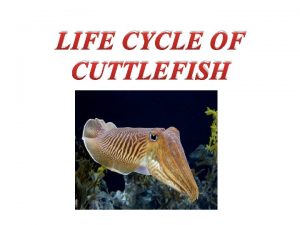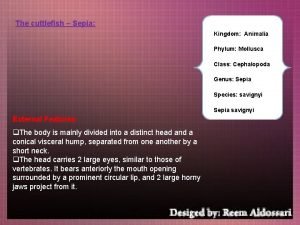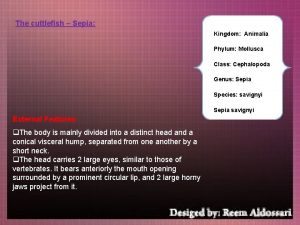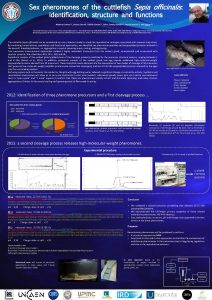LIFE CYCLE OF CUTTLEFISH INTRODUCTION Entire life cycle











- Slides: 11

LIFE CYCLE OF CUTTLEFISH

INTRODUCTION Ø Entire life cycle is occurs in Ocean Ø The life span is Two to three years Ø Breeding season is winter

One important body part is the cuttlebone because the cuttlebone controls the cuttlefish’s buoyancy. The cuttlefish can change their skin to any color. They can also change their body texture to any texture. Cuttlefish are known as "chameleons of the sea" for their ability to change skin color and patterns.

Habitat Cuttlefish live on the sand near to shore. Cuttlefish can be found in seaweed, near logs, somewhere on top of a rock and on the sand.

Adult ( SEA ) OCEANS Eggs & Larvae ( NEAR SHORE ROCKS )


REPRODUCTION

Maturity stages Stage Male Female I Gonad very small and difficult to find II Gonad translucent or whitish, with no structure visible. Nidamental glands enlarged. Accessory nidamental glands appear white III Gonad appears enlarged. No particles visible in Needham's sac Gonad no longer translucent, and some structure visible. Nidamental glands further enlarged. Accessory nidamental glands appear beige-yellow IV Gonad large. spermatophores visible in Needham's sac Gonad large and many eggs visible but may be compressed together in proximal part of oviduct. May be different egg stages in the distal part of the oviduct. Accessory nidamental glands appear orange V Spermatophores in gonoduct. Few or no spermatophores visible in Needham's sac As above but almost all eggs are large (4± 8 mm), most in the proximal part of the oviduct. Accessory nidamental glands may appear red Spent VI

The female on receipt of the spermatophores goes into the den which is usually a deep crack or fissure in the rocks, or even a small cave to spawn. There she draws each egg out of her mantle individually and passes it over the sperm. She lays up to 200 eggs.


Within the eggs, the cuttlefish soon develop and after 4 months, they hatch. The cuttlefish attain maturity and ready to spawn between 18 and 24 months of age.
 Life cycle of cuttlefish
Life cycle of cuttlefish Aspidobranchiata
Aspidobranchiata Cuttlefish echinodermata
Cuttlefish echinodermata Work immersion plan sample
Work immersion plan sample Sally wants to select an entire paragraph
Sally wants to select an entire paragraph Unit 11 radicals homework 5 dividing radicals day 1
Unit 11 radicals homework 5 dividing radicals day 1 Entire radical
Entire radical Mixed radical
Mixed radical Parts of a pub
Parts of a pub It provides structural support for the entire body
It provides structural support for the entire body Undercoverage bias
Undercoverage bias It is the ability of your entire body
It is the ability of your entire body




















